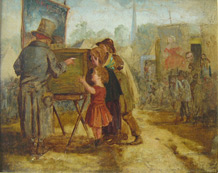
Peepshow
Cinema shows of Christmas past
Well before the invention of cinema, different types of moving and projected images were the height of sophistication for an evening’s entertainment. The Christmas period was particularly popular for visual extravaganza, whether it was family gathered together to view 3D images through the stereoscope, a magic lantern show given to local schoolchildren or the seasonal treat of going to see a gigantic panorama on a huge scroll of canvas depicting adventurous voyages and glorious battles. .
The true extent and impact of these shows in cities, towns and villages across the South West region has been documented by the University of Exeter. A three year research project, funded by the Arts and Humanities Research Council, has explored the weird and wonderful variety of visual entertainment before cinema began. The project focused on Exeter, Bristol and Plymouth, as well as the coastal resorts of Torquay, Weston-Super-Mare, Penzance, Barnstaple and Sidmouth. Using these places the project shows how there was an industry of visual entertainment before the South West enthusiastically embraced the cinema after its introduction in 1896.
It is the first time that a map of popular visual entertainment in the region from 1840 – 1912 has been documented. There was always fun to be had at the ‘pictures’ according to English lecturers Dr Joe Kember and Dr John Plunkett, who led the project. Dr Kember said, ’What we have found is a veritable treasure chest of exhibitions, demonstrating the extent to which there was a thriving industry across the South West of touring and locally produced shows. For example, local football matches were often filmed and shown at the cinema. They were called ‘ Local Pictures’ and the regular slogan up to 1915 was ‘See yourself on screen’.
Plymouth was one of the first cities in the UK to have a cinema. Though the building no longer exists, Andrews’ Pictures were in operation from 1906 in St James’ Hall on Union Street. The location of the cinema was no coincidence because the connection between the naval port and town of Plymouth was an extremely busy thoroughfare. Plymouth was one of the most densely populated cities of the period and provided a steady flow of people who could be enticed to see the latest visual and optical novelty, Across the South West, all classes and age groups participated in the rich array of popular, image-based entertainments, whether it was an audience enjoying a peepshow of a gruesome murder at the fair or an oxy-hydrogen microscope projecting a gigantic cheese mite at a charity bazaar. Many of the shows and exhibitions reflected the spirit of Empire with shows, providing visual travelogues across India and Africa which appealed to the people in the region as places like Plymouth were seen as the pathway to the Great British Empire, via the port.
A flavour of the entertainments on offer was found in a local paper the Western Times, ‘In 1871 at an Exeter fair, an itinerant showmen called out to passing visitors to see ‘panoramas of the “late teherrible war-r on the Continent between Boney’s busters and Billy’s Prooshion boys gents; true and correck views of the principle bloody fights in that disastrous champain.”
The research shows that political groups also used visual entertainment to give credence and draw attention to their messages. The Temperance Society was one of the most prolific, using slides to illustrate the evils of drink and its consequences. Educational groups and missionaries also used popular shows to inform and instruct their audiences. Amusement and spectacle were also extremely popular, with local workhouses and Sundays Schools sometimes given a Christmas treat of a magic lantern show or a trip to the touring panorama spectacle.
The festive season provided a wide range of visual treats, Dr Plunkett explains, ‘ As well as going out to see a touring panorama or pantomime, there were numerous local magic lantern exhibitors who could be hired to come to your house and give a private show for your family and friends, or children might even make their own shadow show to perform’.
Date: 20 December 2010
